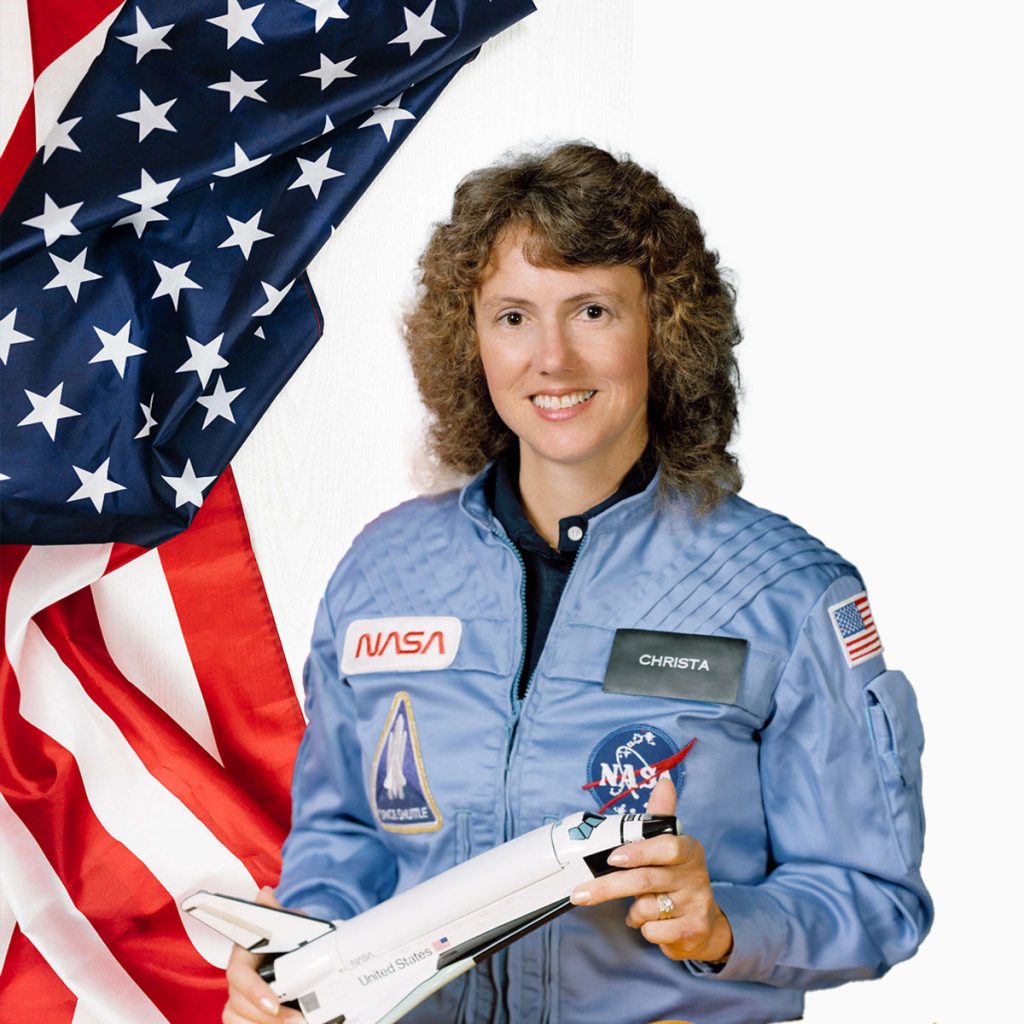
Born in Boston, Massachusetts on September 2, 1948, Christa McAuliffe was the first American teacher chosen to go into space. Her mother, a Lebanese Maronite, was a substitute teacher and her father was an Irish American accountant. She was also the niece of the renowned Lebanese American historian Philip Khuri Hitti who taught at both Harvard and Princeton and created the discipline of Arabic Studies in the United States. Education was always important to her parents between her mom teaching and her father attending Boston College and eventually becoming an assistant comptroller for a Boston department store.
Not long after she graduated from Framingham State College in 1970, McAuliffe married her longstanding boyfriend, Steven McAuliffe and moved to Washington, D.C. where he attended Georgetown Law School. She became a high school teacher specializing in American history and social studies. When her son, Scott, was born, she took time off from teaching and spent her time studying. She went on to receive her master’s degree from Bowie State University in Maryland. The couple and their young son would move to Concord eight years after the couple originally found themselves in the D.C. area, and McAuliffe would take a teaching job at Concord High School in 1982. Not long after the move, the couple’s second child, a daughter named Caroline, was born.
As a girl, McAuliffe was infatuated with the Apollo moon landing program, so in 1984, when she found out about NASA’s efforts to find a teacher to fly on their upcoming Shuttle launch to space, she knew she had to apply. In her application she wrote, “I watched the Space Age being born and I would like to participate.” NASA wanted a gifted educator who could communicate with students from space to rekindle the excitement around the space program. By 1984, shuttle launches had become ordinary occurrences, so NASA decided that involving an ordinary citizen who could be a good “talker” and get people interested and excited in space would reignite the public’s love and fascination with the program. Who better to spark interest and communicate the excitement of space travel than, as President Reagan said at the time, “one of America’s finest, a teacher.”
Although, with over 11,000 applicants total, it seemed as though the odds were against her, McAuliffe was ultimately chosen to be the first teacher to fly in space. She took a year-long leave of absence from teaching in the 1984-1985 school year to prepare for the 1986 Shuttle launch of the Challenger. She proved to be the perfect candidate. A firm believer in hand-on experience, McAuliffe referred to her mission on the Challenger as “The Ultimate Field Trip.” This was fitting since she was often called, “The Field Trip Teacher.” Her students loved her and her teaching style, and she had an almost instant rapport with the media.
While onboard the Challenger, McAuliffe was intended to teach two lessons from space to students back on earth. In her first lesson she planned to introduce each flight member, explain their roles, show the cockpit with its 1,300 switches and dials, and explained how the crew ate, slept, and exercised in space. In the second lesson she intended to explain how the shuttle flew, discussed why we explore, and report on the technological advances created by the space program. She also wanted to keep a journal throughout her journey inspired by the pioneer women who had left their homes searching for a new frontier. Sadly, McAuliffe would not achieve any of these plans.
On January 28, 1986, after months of planning and training, the Challenger was set to launch at 11:38 a.m. EST from Cape Canaveral, Florida as the nation watched with excitement. However, just 73 seconds after launching, disaster struck when an “O-ring” seal in one of the two solid-fuel rockets failed due to the cold temperatures at launch time causing a chain reaction that led to the shuttle breaking apart in a forking plume of smoke and fire. There were no survivors. It was the first major space shuttle accident, and the country looked on in shock and disbelief. President Reagan appointed a special commission that included Neil Armstrong to investigate what went wrong with the launch. After the tragedy NASA did not send astronauts into space for more than two years until it finally launched the Discovery in September of 1988.
Although McAuliffe’s mission on the Challenger ended, her mission as a teacher lives on. Today, McAuliffe’s legacy is kept alive in numerous books, including the one by her mother, Grace Corrigan, A Journal for Christa: Christa McAuliffe, Teacher in Space which paid homage to the journal McAuliffe was meant to keep during her flight. She has also been honored in name through the Christa Corrigan McAuliffe Center for Education and Teaching Excellence at her alma mater, Framingham State University, the McAuliffe-Shepard Discovery Center in Concord, Connecticut, the Christa McAuliffe Intermediate School in Brooklyn, New York, the McAuliffe Branch Library in Framingham, Massachusetts, the Christa McAuliffe Adult Learning Center in Baton Rouge, Louisiana, the S. Christa McAuliffe Elementary School in Lowell, Massachusetts, and even craters on the moon and Venus (both called “McAuliffe”). The later crater was actually named by the Soviet Union. However, her honors do not stop there. There are also awards, an annual technology conference, grants, and more bearing her name. She was beloved by the nation and beyond, and her love of space and technology have lived on to inspire generations.
References
Farmingham Public Library. (no date). McAuliffe branch. McAuliffe Branch. https://framinghamlibrary.org/mcauliffe-branch
History (2020, January 28). The space shuttle Challenger explodes after liftoff. A&E, https://www.history.com/this-day-in-history/challenger-explodes
Lebanese Monthly (2007). 20 years later…Remembering Lebanese American astronaut Christa McAuliffe. Lebanese Monthly, 1(2), pp. 18. https://web.archive.org/web/20090304125359/http://www.lebanesemonthly.com/magazines/lebanese_monthly_volume-01_issue-02.pdf
NASA (2004, October 22). The crew of the Challenger shuttle mission in 1986. National Aeronautics and Space Administration. https://www.hq.nasa.gov/pao/History/Biographies/challenger.html
USGS (no date). Gazetteer of Planetary Nomenclature. Department of the Interior. https://planetarynames.wr.usgs.gov/Feature/3777